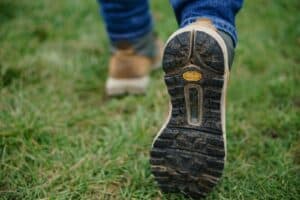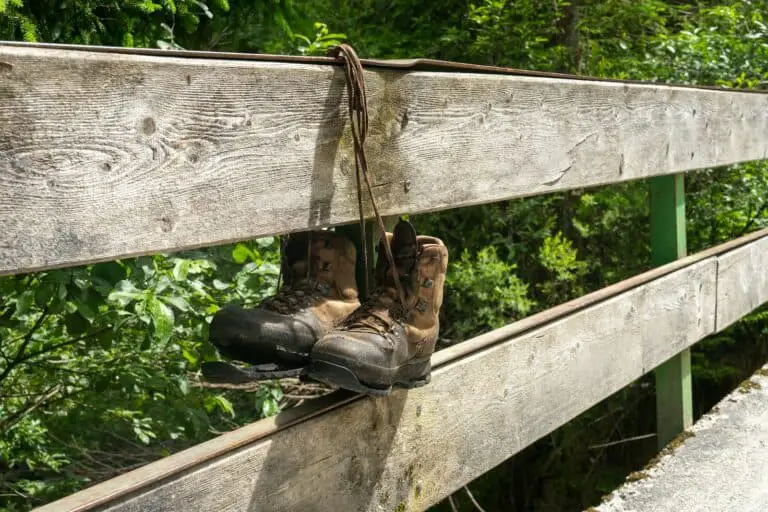Ever had a hiking trip ruined by a busted boot? I know I have. It’s not just about comfort, it’s about safety too. Knowing when your hiking boots are worn out is crucial for every outdoor enthusiast.
How to tell if hiking boots are worn out? In this article, I’ll share some telltale signs that it’s time to retire your old pair. We’ll look at indicators like worn out soles, damaged uppers, and uncomfortable fit.
Let’s ensure your next hiking adventure isn’t marred by footwear failure. Stay tuned to learn how to assess the condition of your hiking boots and when it’s time to invest in a new pair.
Signs of Worn-out Soles

When it comes to identifying worn-out soles on your hiking boots, there are a couple of things you’ll want to look out for.
Irregular Wear Patterns
The first one is irregular wear patterns. After prolonged use, it’s normal for boot soles to exhibit some wear, but uneven wear could point to a problem. If you notice wear on just one side of the hiking boot or in specific spots only, it implies that the boot is misaligned, affecting its efficiency.
Decreased Traction
Another critical issue is decreased traction. Good soles provide reliable traction on a variety of outdoor surfaces. They’re designed to grip onto rocks, dirt, and other terrain you’ll encounter on your hikes. If you find yourself slipping more than usual or struggling to gain a foothold, it’s a sign your soles are wearing thin.
Visible Damage
Visible damage is also a sign of worn-out soles. Sometimes wear and tear may be more apparent than subtle. If you can see through the sole to the boot’s inside, or cracks are appearing on the surface, it’s evident the boots are past their prime. Such boots won’t just underperform but can put you at risk of injury.
Indicators of Damaged Uppers
Once you’ve examined the soles of your boots, it’s crucial to shift your focus to the uppers. This is the part of the boot that covers your foot from the soles upwards, offering protection and form-fitting comfort during your hikes. If intact, they’ll serve you well in rugged terrains, but if damaged, can cause all sorts of issues.
First off, pay attention to the material. Leather or synthetic materials used in the uppers tend to deteriorate with time and usage, often leading to holes and tears. While minor damage might not immediately impact your hikes, over time, these tears can grow, exposing your foot to sharp rocks, water, or cold air. Besides physical discomfort, they open possibilities for foot injuries.
Another significant problem that arises with worn-out uppers is inadequate support. When the upper part of your boots loosens due to wear, it’s unable to provide essential ankle support. This might seem inconsequential, but a lack of support on uneven terrain can increase the risk of ankle sprains or worse.
Here is a quick checklist to identify if the uppers of your boots are in a healthy state:
- Check for visible damage, such as: tears, obvious holes, or worn areas.
- Inspect the tightness of the uppers. They should feel firm, not loose around your ankle.
- Check if the boots are still waterproof. Water seeping in is a clear sign of material breakage.
Most boot problems start small, but if ignored, they can quickly spiral out of control leading to discomfort, loss of function, or risk of injury. In light of these factors, a thorough inspection of your hiking boots is crucial before setting out on your next adventure. There’s no better time than now to do a quick check-up on your trusty hiking partners to ensure they’re ready for your next expedition. So go ahead and give your boots the attention they deserve.
Recognizing an Uncomfortable Fit

Let me explain how an uncomfortable fit becomes a clear indicator that your hiking boots need a goodbye party. The uncomfortable fit is just as crucial an indicator as damaged uppers and is more important in some cases, where physical discomfort directly impacts the quality of your hiking experience.
When we talk about how a boot fits, it’s not about if it squeezes your foot or gives you blisters after walking a short distance. It’s about being aware of subtle changes over time. It’s crucial to understand that a boot that has served many hiking trips can change its shape and lose its original fit. When this occurs, your boot’s protective and supportive features become compromised, and the shoe can cause discomfort during hikes, which can lead to injuries.
Here are some cues to recognize an uncomfortable fit:
- Pressure points: If your boots are causing pressure at specific points on your feet, it could mean that these shoes have deformed with time and need replacing.
- Loose feel: If your boots, which used to fit snugly, now feel loose and your foot moves excessively, they’ve likely stretched or worn out too much.
- Discomfort during and after hikes: Don’t ignore any discomfort during or after your hikes. If your feet are continually sore or if you’re getting frequent blisters, these are significant red flags that your boots are past their prime.
So remember, to maintain the enjoyment and safety of your hiking experience, stay attentive to the fit of your hiking boots over time. Constant discomfort is a sure sign that it’s high time to invest in a new pair. You might want to think your boots have a lot of life left, but it’s important, for your comfort and safety’s sake, that you acknowledge when they’re showing signs of retirement. Regular assessment and acknowledging an uncomfortable fit is the first step towards ensuring a more comfortable and safer hiking experience.
The Importance of Adequate Tread

So we’ve talked about poor fit and the discomfort it causes. Now, let’s shift our focus to another significant aspect of hiking boots that’s often overlooked, the tread. The tread of your boots can make a world of difference during a hike. It not only provides firm ground traction but also offers stability, especially on slippery or uneven terrains.
If you’re like me, you’d agree that one of the most exhilarating aspects of hiking is tackling different trails and environments. Embarking on hikes, from leaf-laden forest paths in autumn to snowy hill climbs in winter, can challenge you in fresh and exciting ways. But with varying surfaces comes the need for dependable traction. And that’s precisely what a good tread offers.
Identifying worn-out tread
Take a look at your boots. If you see that the tread pattern is significantly worn down or entirely smoothed in some areas, it’s a strong indicator that they’re past their prime. Particularly pay attention to the heel and the ball of the foot, the two areas that suffer the most wear. Are they flatter than they used to be? If the answer’s yes, then it’s time to take this as a sign that your boots are due for retirement.
Remember, a worn-out tread isn’t just about underperforming on your hikes. It’s a safety issue too. I cannot stress this enough_- the last thing you want is to slip and fall during a hike.
As we continue discussing the ranks of footwear deterioration, let’s move on to another crucial aspect, the condition of the midsole. This component, lying silently between the insole and the outsole, plays a significant role in your hiking comfort and endurance. The midsole is responsible for your boots’ cushioning and shock absorption, making it an essential factor to consider when evaluating the retirement timeline for your hiking boots. Let’s dive further into it in the following section.
Conclusion: How to Tell if Hiking Boots are Worn Out
So, that’s the lowdown on telling if your hiking boots are worn out. Remember, discomfort is a key sign – if your boots don’t feel right, it’s time to give them a break. Also, keep a close eye on the tread. If it’s significantly worn, especially on the heel and ball of the foot, your boots are not giving you the traction you need. Finally, don’t forget about the midsole. It’s what provides the cushioning and shock absorption, and if it’s worn down, your hiking experience won’t be as comfortable or safe. Now that you know what to look for, you’ll be able to make the call when it’s time to retire your boots. Happy trails!


